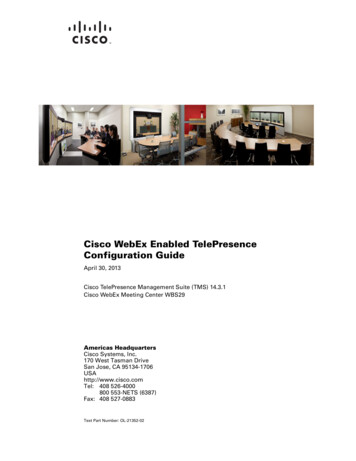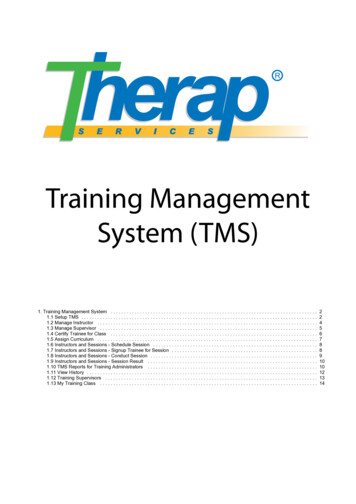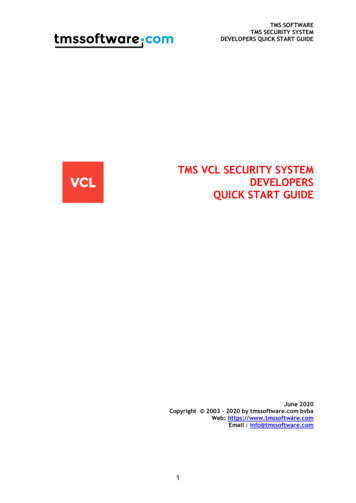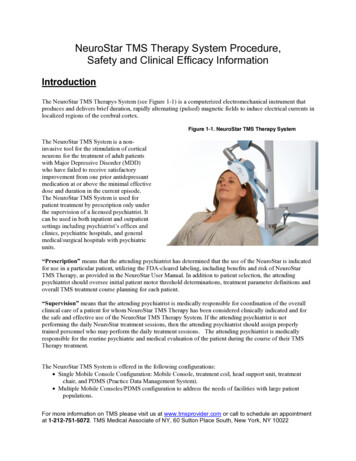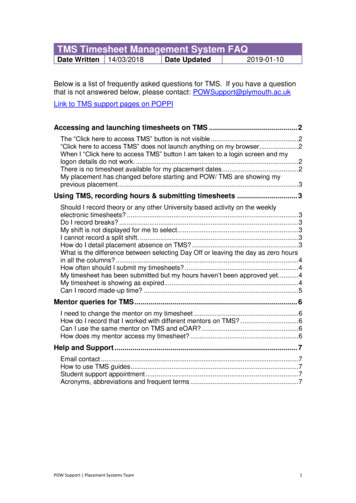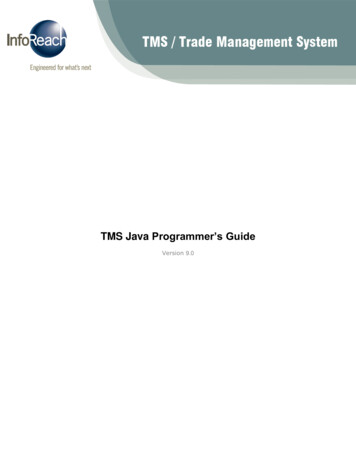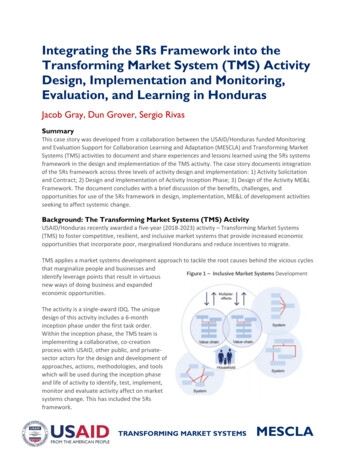
Transcription
TMS-6016 TelemetryMonitoring SystemOperator’s Manual
Copyright 2008-2012 Shenzhen Mindray Bio-Medical Electronics Co., Ltd. All rightsreserved.For this Operator’s Manual, the issue date is 2012-11.WARNINGzFederal Law (USA) restricts this device to sale by or on the order of a physician.I
Intellectual Property StatementSHENZHEN MINDRAY BIO-MEDICAL ELECTRONICS CO., LTD. (hereinafter calledMindray) owns the intellectual property rights to this Mindray product and this manual.This manual may refer to information protected by copyrights or patents and does notconvey any license under the patent rights of Mindray, nor the rights of others.Mindray intends to maintain the contents of this manual as confidential information.Disclosure of the information in this manual in any manner whatsoever without the writtenpermission of Mindray is strictly forbidden.Release, amendment, reproduction, distribution, rental, adaption and translation of thismanual in any manner whatsoever without the written permission of Mindray is strictlyforbidden.,andare the registered trademarks or trademarks owned byMindray in China and other countries. All other trademarks that appear in this manual areused only for editorial purposes without the intention of improperly using them. They arethe property of their respective owners.II
Responsibility on the ManufacturerPartyContents of this manual are subject to changes without prior notice.All information contained in this manual is believed to be correct. Mindray shall not beliable for errors contained herein nor for incidental or consequential damages in connectionwith the furnishing, performance, or use of this manual.Mindray is responsible for the effects on safety, reliability and performance of this product,only if: all installation operations, expansions, changes, modifications and repairs of thisproduct are conducted by Mindray authorized personnel; the electrical installation of the relevant room complies with the applicable nationaland local requirements; the product is used in accordance with the instructions for use.WARNINGzThis equipment must be operated by skilled/trained clinical professionals.zIt is important for the hospital or organization that employs this equipment tocarry out a reasonable service/maintenance plan. Neglect of this may result inmachine breakdown or personal injury.III
WarrantyTHIS WARRANTY IS EXCLUSIVE AND IS IN LIEU OF ALL OTHER WARRANTIES,EXPRESSED OR IMPLIED, INCLUDING WARRANTIES OF MERCHANTABILITYOR FITNESS FOR ANY PARTICULAR PURPOSE.IV
ExemptionsMindray's obligation or liability under this warranty does not include any transportation orother charges or liability for direct, indirect or consequential damages or delay resultingfrom the improper use or application of the product or the use of parts or accessories notapproved by Mindray or repairs by people other than Mindray authorized personnel.This warranty shall not extend to Malfunction or damage caused by improper use or man-made failure. Malfunction or damage caused by unstable or out-of-range power input. Malfunction or damage caused by force majeure such as fire and earthquake. Malfunction or damage caused by improper operation or repair by unqualified orunauthorized service people. Malfunction of the instrument or part whose serial number is not legible enough. Others not caused by instrument or part itself.V
Company ContactManufacturer:Shenzhen Mindray Bio-Medical Electronics Co., Ltd.E-mail Address:service@mindray.comTel: 86 755 81888998Fax: 86 755 26582680EC-Representative:Shanghai International Holding Corp. GmbH(Europe)Address:Eiffestraβe 80, 20537 Hamburg, GermanyTel:0049-40-2513175Fax:0049-40-255726VI
PrefaceManual PurposeThis manual contains the instructions necessary to operate the telemetry monitoring systemsafely and in accordance with its function and intended use. Observance of this manual is aprerequisite for proper product performance and correct operation and ensures patient andoperator safety.This manual is based on the maximum configuration and therefore some contents may notapply to your telemetry monitoring system. If you have any question, please contact us.This manual is an integral part of the product. It should always be kept close to theequipment so that it can be obtained conveniently when needed.Intended AudienceThis manual is geared for clinical professionals who are expected to have a workingknowledge of medical procedures, practices and terminology as required for monitoring ofcritically ill patients.IllustrationsAll illustrations in this manual serve as examples only. They may not necessarily reflectyour monitoring setup or data displayed on your telemetry monitoring system.Conventions Italic text is used in this manual to quote the referenced chapters or sections. The terms danger, warning, and caution are used throughout this manual to point outhazards and to designate a degree or level or seriousness.VII
FOR YOUR NOTESVIII
Contents1 Safety . 1-11.1 Safety Information . 1-11.1.1 Dangers . 1-21.1.2 Warnings. 1-21.1.3 Cautions . 1-31.1.4 Notes . 1-41.2 Equipment Symbols . 1-52 Overview . 2-12.1 General . 2-12.1.1 Intended Use. 2-12.1.2 Contraindications . 2-22.1.3 Components . 2-22.1.4 Functions . 2-22.2 Product Overview . 2-32.2.1 Telemetry Transmitter . 2-32.2.2 Telemetry Receiver . 2-52.3 About The Central Monitoring System . 2-72.3.1 Display . 2-72.3.2 Multibed Screen . 2-132.3.3 Viewbed Screen. 2-183 Installation and Maintenance. 3-13.1 Installation. 3-13.1.1 Unpacking and Inspection. 3-13.1.2 Environmental Requirements. 3-23.1.3 Power Requirements . 3-23.1.4 Installation. 3-33.1.5 Starting the System. 3-43.1.6 Shutting down the System. 3-53.2 Maintenance . 3-63.2.1 Inspection . 3-63.2.2 Cleaning . 3-73.2.3 Disinfection and Sterilization. 3-84 Using Transmitters. 4-14.1 Installing and replacing batteries. 4-14.2 Switching on/off the transmitter. 4-24.3 Wearing the transmitter . 4-25 CMS Operation . 5-11
5.1 Nurse call . 5-15.2 Event . 5-15.3 STANDBY . 5-25.4 Patient Management. 5-25.4.1 Admitting a Patient. 5-25.4.2 Modifying Patient Information. 5-35.4.3 Discharging a Patient . 5-45.5 Managing Parameter Settings . 5-55.6 Review . 5-65.6.1 Dynamic Short Trend . 5-65.6.2 Waveform Review. 5-65.6.3 Trend Review . 5-65.6.4 Event Review . 5-75.6.5 ST Review. 5-75.7 Record . 5-85.7.1 Recording Patient Information . 5-85.7.2 Recording Normal Waveforms. 5-85.7.3 Recording Events . 5-85.7.4 Recording ST Segment Waveform . 5-85.7.5 Recording Real-time Waveforms . 5-95.7.6 Recording Real-time Frozen Waveforms . 5-95.7.7 Recording Real-time Alarms. 5-95.8 Print. 5-105.8.1 Printing Patient Information. 5-105.8.2 Printing Trend Graph or Trend Table . 5-105.8.3 Printing Normal Waveforms. 5-105.8.4 Printing ECG Report .5-115.8.5 Printing Compressed Waveforms .5-115.8.6 Printing ARR Statistic Result .5-115.8.7 Printing Event List .5-115.8.8 Printing an Event. 5-125.8.9 Printing ST Segment Waveform. 5-125.8.10 Printing Multi-lead ECG . 5-125.8.11 Printing in Real-time . 5-126 Alarm. 6-16.1 Alarm Categories. 6-16.2 Alarm Priorities . 6-26.3 Alarm Indicators. 6-26.3.1 Audible Alarms. 6-36.3.2 Reminder Tone . 6-36.3.3 Alarm Messages . 6-46.3.4 Color Changes. 6-46.3.5 Flashing Numeric . 6-42
6.4 Alarm Status Symbols . 6-56.5 Alarm Setup. 6-56.6 Alarm Volume . 6-66.7 Alarm Delay Setup . 6-66.8 Alarm Level Setup . 6-66.9 Alarm Pause . 6-76.10 Alarm Silencing. 6-76.11 Alarm Latching. 6-86.12 CMS System Silence. 6-86.13 CMS Alarm Audio Off . 6-97 ECG Monitoring. 7-17.1 Preparation . 7-17.2 Electrode Placement. 7-27.2.1 3-Leadwire Electrode Placement . 7-37.2.2 5-Leadwire Electrode Placement . 7-37.2.3 Characteristics of a Good Signal. 7-67.3 ECG Monitoring . 7-77.3.1 ECG Waveform Area. 7-77.3.2 ECG Parameter Area . 7-87.3.3 ECG Setup Screen. 7-97.3.4 ECG Lead Type. 7-97.3.5 Wave Speed . 7-107.3.6 HR Source . 7-107.3.7 Wave Gain . 7-107.3.8 Filter Mode. 7-107.3.9 Pacer Pulse Detection.7-117.3.10 Pacer Reject on Waveform .7-117.3.11 Pacer Rate. 7-127.3.12 HR Alarm . 7-127.4 ST Analysis . 7-137.4.1 General . 7-137.4.2 Switching on/off ST Analysis. 7-137.4.3 Setting ST Parameter Display . 7-147.4.4 Setting ST Alarm. 7-147.4.5 Defining ST Point. 7-147.5 Arrhythmia Analysis. 7-167.5.1 Overview . 7-167.5.2 Arrhythmia Events . 7-177.5.3 Arrhythmia Alarm Setup . 7-177.5.4 Arrhythmia Threshold Setup . 7-187.5.5 Arrhythmia Alarm Review . 7-187.5.6 Arrhythmia Relearn. 7-197.5.7 Arrhythmia Troubleshooting . 7-203
7.6 Maintenance and Cleaning . 7-208 Troubleshooting. 8-18.1 Common Physiological Alarms and Troubleshooting. 8-28.2 Common Problems and Troubleshooting. 8-49 Accessories . 9-19.1 ECG. 9-19.1.1 ECG Electrodes. 9-19.1.2 Cable Sets. 9-19.2 Others . 9-2A Product Specifications. A-1A.1 Safety Specifications . A-1A.2 Environmental Specifications. A-1A.3 Power Specifications . A-2A.4 Physical Specifications. A-3A.5 Data Display, Recording and Storage. A-3A.6 Alarms and Indicators. A-4A.7 Wireless Transmission. A-4A.8 ECG Specifications . A-5B Factory Defaults .B-1C EMC . C-1D FCC Compliance . D-1E Symbols and Abbreviations .E-1E.1 Units . E-1E.2 Symbols . E-2E.3 Abbreviations. E-34
1 Safety1.1 Safety InformationThe safety statements presented in this chapter refer to the basic safety information that theoperator of the Telemetry monitoring system shall pay attention to and abide by. There areadditional safety statements in other chapters or sections, which may be the same as orsimilar to the followings, or specific to the operations.DANGERzIndicates an imminent hazard situation that, if not avoided, will result in death,serious injury or property damage.WARNINGzIndicates a potential hazard situation or unsafe practice that, if not avoided,could result in death, serious injury or property damage.CAUTIONzIndicates a potential hazard or unsafe practice that, if not avoided, could resultin minor personal injury or product/property damage.NOTEzProvides application tips or other useful information to ensure that you get themost from your product.1-1
1.1.1 DangersThere are no dangers that refer to the product in general. Specific “Danger” statements maybe given in the respective sections of this operation manual.1.1.2 WarningsWARNINGzThe telemetry monitoring system is intended for use by trained clinicalprofessionals in specific situations. Any operations of the system byunauthorized or untrained person are prohibited.zCheck the system and accessories each time before use. Make sure they functionproperly and safely.zPossible fire or explosion hazard if used in the presence of flammableanesthetics.zDo not use this equipment in conjunction with electro-surgery unit (ESU).zBe sure to set the alarm according to the patient’s conditions. Make sure thesystem sounds when an alarm is present.zOpening the receiver housing may present a risk of electric shock. All servicingand future upgrades to this system must be performed by personnel trained andauthorized by Mindray only.zDo not come into contact with patients or transmitter during defibrillation.Otherwise serious injury or death could result.zDispose of the packaging material, observing the applicable waste controlregulations and keeping it out of children’s reach.zThe telemetry receiver must be connected to a properly installed power outletwith protective earth contacts only. If the installation does not provide for aprotective earth conductor, disconnect the receiver from the power line andoperate it on battery power, if possible.zThe equipment generates and uses RF energy. If it is not installed correctly orused by observing the manual, RF interference to other devices could result.zThe telemetry system transmits through space wireless signals. During thisprocess, signals may be interfered by multiple sources of RF interference.Although the telemetry system has certain capability against interference,occasional transmission failure could occur.zThe telemetry transmitter is an IPX3 device. Never immerse the telemetrytransmitter in water or other liquids such as cleaning solutions.1-2
WARNINGzThe equipment is not capable of rejecting pacer pulse. Keep pacemaker patientsunder close observation.zAfter the first deploy of antenna array, or after hospital’s buildingreconstruction or re-decoration, clinician shall confirm the coverage of antennaarray, and shall require patients to move around within the confirmed area.Clinician should arrive on time within the area.1.1.3 CautionsCAUTIONzTo ensure patient safety, use only parts and accessories specified in this manual.zRemove the batteries if you do not intend to use the transmitter for a longperiod of time.zDisposable devices are intended for single use only. They should not be reused asperformance could degrade or contamination could occur.zAt the end or its service life, the product described in this manual, as well as itsaccessories, must be disposed of in compliance with the guidelines regulating thedisposal of such products. If you have any questions concerning disposal of theproduct, please contact us.zMagnetic and electrical fields are capable of interfering with the properperformance of the system. For this reason make sure that all external devicesoperated in the vicinity of the system comply with the relevant EMCrequirements. Mobile phone, X-ray equipment or MRI devices are a possiblesource of interference as they may emit higher levels of electromagneticradiation.zBefore connecting the receiver to the power line, check that the voltage andfrequency ratings of the power line are the same as those indicated on the unit’slabel or in this manual.zInstall or carry the transmitter properly to avoid damage caused by drop,impact, strong vibration or other mechanical force.zSignal transmission can be disturbed when the patient passes concrete walls orelevator doors.zHigh quality alkali batteries are recommended. Remove the batteries when thetransmitter is not in use.zAlthough the transmitter and receiver are chemically resistant to most commonhospital cleaners and non-caustic cleaners, different cleaners are not1-3
CAUTIONrecommended and may stain the transmitter and receiver. Many cleaners mustbe diluted before use.zInsert the silica gel plug into the programming port when the programmingcable is not attached to the transmitter.1.1.4 NotesNOTEzKeep this manual close to the Telemetry monitoring system so that it can beobtained conveniently when necessary.zFor detailed introductions of the central monitoring system, refer to theoperator’s manual of the central monitoring system.zChoose a location that affords an unobstructed view of the system and easyaccess to the operating controls.zThe instructions of this manual are based on the maximum configuration. Someof them may not apply to your system.1-4
1.2 Equipment SymbolsAttention: Consult accompanying documents (this manual).Power onPower offAlternating current (AC)Type CF applied part. The unit displaying this symbol contains anF-type isolated (floating) patient part providing a high degree ofprotection against shock, and is suitable for use duringdefibrillation.Equipotential terminalNon-ionizing electromagnetic radiationNetwork connectorAntenna interfaceCommunication statusManufacture dateSerial number1-5
European community representativeThe following definition of the WEEE label applies to EUmember states only.This symbol indicates that this product should not be treated ashousehold waste. By ensuring that this product is disposed ofcorrectly, you will help prevent bringing potential negativeconsequences to the envi
This manual contains the instructions necessary to operate the telemetry monitoring system safely and in accordance with its function and intended use. Observance of this manual is a prerequisite for proper product performance and correct operation and ensures patient and operator safety.
